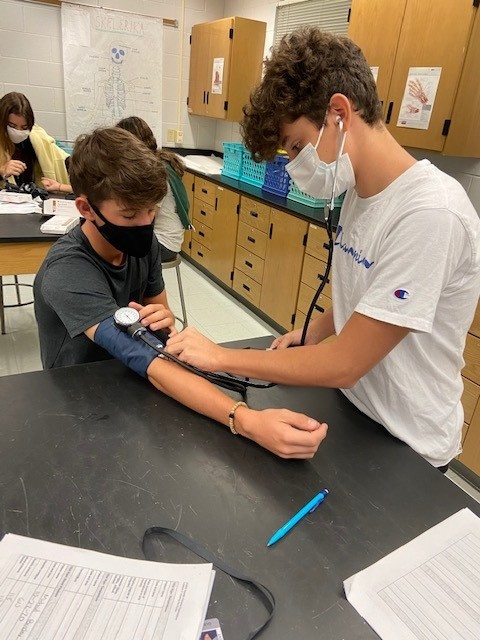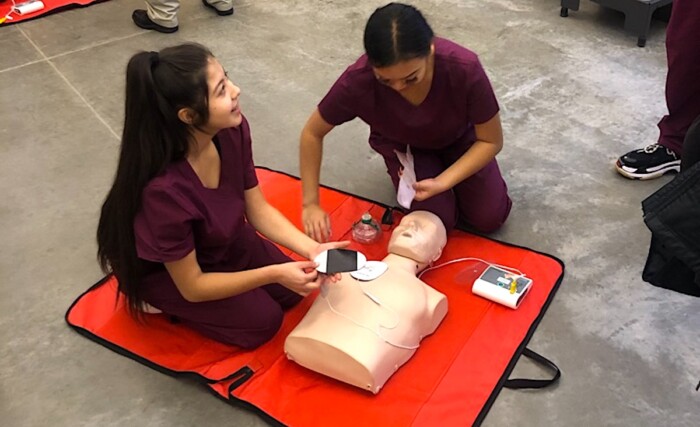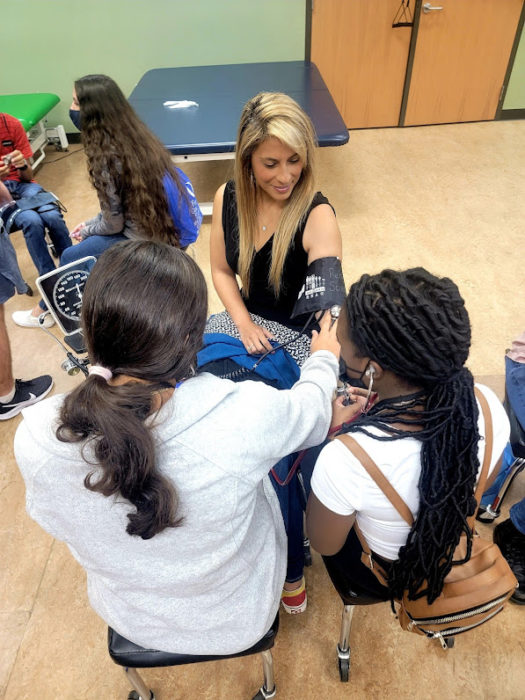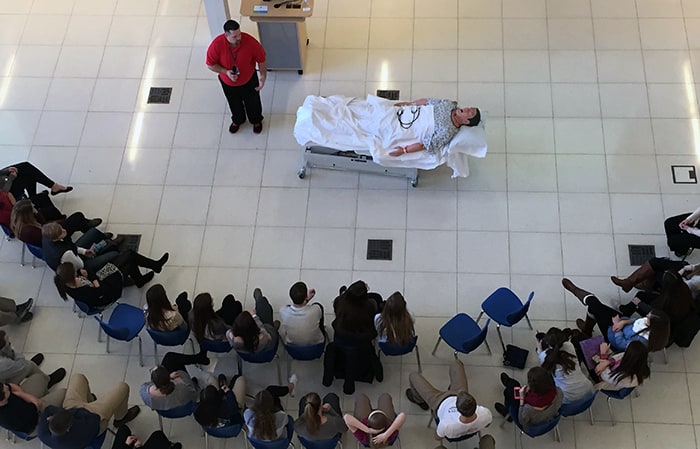Introduction
The health sciences sector is full of emerging opportunities. Harnessing the power of synthetic biology and artificial intelligence will unlock new possibilities for preventing, diagnosing, and treating diseases, ultimately improving human health, well-being, and longevity. For the next decade, health sciences will have one of the highest job growth potentials of any pathway and will also unleash the greatest entrepreneurial opportunities. Policy challenges range from age restrictions on formal internships and balancing access to more systemic and philosophical challenges like grappling with data privacy, gene editing, and caring for an aging population.
While to date, health fields have specialized in treatment, over the next few years, the sector will become increasingly personalized and preventative, meaning the merging of health jobs with community wellness roles. This holistic approach to health will encompass physical, mental, and social well-being, with a focus on preventive care to reduce chronic disease incidence. Recognizing the importance of social determinants of health, integrated care models now combine medical services with social support, fostering collaboration among healthcare providers, social workers, and wellness professionals. Increased funding, policy support, and advancements in digital health technologies further facilitate this integration, enabling comprehensive and community-focused healthcare services. More specifically, with an aging population, there will be an increased need for geriatric medicine and senior care.
On the technology front, multi-modal artificial intelligence is set to radically change the diagnostic and telemedicine industry in the next 1-3 years, making precision diagnoses from afar and generating referrals and advice as a first touch. These technologies will also radically open the gates of possibility for new entrepreneurial ventures and real-time data. Because much of the health sector is dependent on licensure, this industry is ripe for entrepreneurial disruption. That said, in most health pathways there is little focus on business, finance, or administration. These lateral pathways skills will be key to building into next-generation health science pathways, in addition to computer science, STEM, and more.
As we grapple with global health challenges and technological advancements, the demand for skilled health professionals has never been greater. Yet, a significant gap looms ahead: a burgeoning demand for health professionals contrasted starkly with insufficient interest and engagement among youth. In the following sections, you’ll see pioneering examples of industry and educational partnerships that are working to bridge this gap through career exploration, skills development, and community connections.
Early exposure to health-related curricula and careers can ignite lifelong passions and direct students toward fulfilling and critically needed roles in society. However, despite the clear need and opportunities within this field, many students remain unaware of the potential careers beyond traditional roles such as doctors or nurses. This is partly due to a lack of comprehensive health sciences programs in early education and a pervasive misunderstanding of the field’s scope among students and educators alike. These jobs are key pathways to economic mobility, most are not at risk of automation and many of them do not require a four-year degree.
[…] because we’ve done comparatively little in this country to grow apprenticeships beyond their cozy home in construction. In Europe and Australia, it’s common to find apprentices in financial services, healthcare, and technology.
Ryan Craig
There are an estimated two million open healthcare industry jobs and an additional two million are expected by 2031. According to a report from Josh Bersin, “the traditional solutions of recruiting new hires, retaining employees, and reskilling the workforce will only close half of the predicted future provider gap.”
Industries
When we say Health Sciences, we’re talking about a wide swath of industry applications captured by some of the following bigger buckets:
- Biotechnology and Pharmaceuticals: This industry focuses on the research, development, and production of biotechnological and pharmaceutical products, including medicines, vaccines, and diagnostics.
- Healthcare Services: This broad category includes hospitals, clinics, and private practices where medical professionals such as doctors, nurses, and therapists provide direct patient care. It also covers ancillary services such as imaging, laboratory work, and emergency care.
- Public Health: This sector is concerned with the prevention of disease and the promotion of health at the community and population levels. It includes roles in epidemiology, health education, environmental health, and health policy.
- Medical Devices and Equipment: This industry involves the design, manufacture, and supply of medical devices and equipment, ranging from surgical instruments to advanced diagnostic machines.
- Health Informatics and Information Management: Specializing in the management of healthcare data and information systems, this industry focuses on improving patient care through technology. It includes health information management and health informatics professionals.
- Research and Development: This area focuses on scientific research related to understanding various diseases and developing new treatments and health technologies.
- Mental Health Services: This industry includes the provision of mental health care and counseling services, addressing mental illnesses and promoting mental well-being.
- Rehabilitation Services: Specializing in helping patients recover, maintain, or improve physical and cognitive abilities that have been impaired, this industry includes physical therapists, occupational therapists, and speech-language pathologists.
- Long-term Care and Support: This sector focuses on providing long-term care services for individuals who need assistance with everyday activities, such as the elderly or those with chronic conditions or disabilities.
Roles
As indicated by this short list of possible future roles, there is a large opportunity for entrepreneurship in this sector. Students should be exposed to both global challenges and trends, as well as emerging technology and asked questions about global health to spur innovative ideas. A rough list of emerging entrepreneurial opportunities are:
- Genomic Sequencing Services
- Biotech Drug Development
- CRISPR Technology Applications
- Microbiome Therapeutics
- Telehealth Platforms
- Wearable Fitness Technology
- Nutritional Genomics
- Mental Health Tech
- Regenerative Medicine
- Healthcare IT Solutions
- Virtual Reality for Therapeutic Use
- Healthcare Facilities Management
- Healthcare Robotics
- Elderly Care Technology
- Health and Wellness Retreats
- Environmental Health Solutions
Credentials
Although many of these programs offer some credentials, this space is still ripe for innovation. In Missouri, schools have identified five micro-credentials in biotech that map to the Project Lead the Way biomedical sciences pathways. These credentials can be earned as early as freshman/sophomore year and serve as an effective retainment strategy for keeping students in the program. These credentials are being developed with the Bioscience Core Skills Institute (CoreSkills Institute).
Pre-existing licenses and credentials are great ways to earn a higher wage, be competitive in the job market and have real-world experiences that help inform affinities. A few licenses growing in utility and capable of setting students apart:
- Phlebotomy Technician Certification: A phlebotomy certification allows individuals to collect blood samples from patients. It’s a specialized skill that can be useful in many healthcare settings.
- Certified Nursing Assistant (CNA): High school students can often take courses to become a CNA, which provides an excellent introduction to patient care. CNAs work under the supervision of nurses to provide basic care to patients.
- Emergency Medical Technician (EMT) Certification: This certification is more advanced and involves a more significant time commitment but can provide invaluable experience in emergency medical services. EMTs learn how to respond to emergency situations and provide critical care in the field.
Common licenses that high schoolers may be able to get:
- CPR and First Aid Certification: Basic yet essential, CPR (Cardiopulmonary Resuscitation) and First Aid certifications are fundamental for anyone looking to enter the healthcare field. These certifications are often offered by organizations such as the American Red Cross and the American Heart Association.
- Medical Scribe Training: While not always requiring formal certification, becoming a medical scribe involves learning medical terminology and documentation practices. Medical scribes work alongside physicians to take notes during patient visits, allowing doctors to focus more on patient care.
- Certified Phlebotomy Technician – National Phlebotomy Association (NPA)
- Certified Patient Care Technician – National Healthcareer Association (NHA)
- Certified Electrocardiography (EKG) Technician — National Healthcareer Association (NHA)
- Cardiopulmonary Resuscitation (CPR) Certification — American Heart Association (AHA)/American Red Cross
What Can K-12 Schools Do About It?
From elementary through high school, these programs are not just about teaching biology or chemistry; they are about creating immersive, hands-on experiences that reveal the real-world impact of health sciences. This includes partnerships with local hospitals, research projects with universities, and technology-driven simulations that bring the human body and its complexities to life.
In order for these pathways to stay nimble, many of the health science pathways are mapped to the Allied Health Core Curriculum. By approaching pathways through this lens, students personal interest is able to drive their entry point and enables them to gather broader skills as they are on the journey for more specific pathways.
Multiple large foundations have set their sights on enabling careers in Health Science through radical giving and focus. The Kauffman Foundation in Kansas City has been working to create Real World Learning definitions and map them to Health Science pathways. Bloomberg Philanthropies recently announced a $250 million initiative to create new high schools nationwide that will graduate students directly into high-demand healthcare jobs with family-sustaining wages. This first-of-its-kind initiative pairs public education systems and hospitals in 10 communities including urban and rural locations. From the press release, “As part of this initiative, all health system partners have committed to providing job opportunities for students who successfully complete the graduation requirements of their respective programs.”
Additionally, the CHIPS and Science Act enables high schools to leverage federal dollars to create more robust STEM programming, much of which supports a career in the broad and interdisciplinary health sciences sector.
By highlighting these and other success stories, this publication urges school districts nationwide to consider the relevancy of their pre-existing health pathways, while also calling on districts without clearly articulated health science pathways to reconsider and begin development. It is a call to action for educational leaders to recognize the critical role they play in the workforce pipeline, ensuring that students are not only aware of but are prepared for the vast opportunities that a career in the health sciences holds.
Pathway Resources
Numerous resources exist to support career exploration and curriculum development, while also providing the tools needed by teams of guidance and advisory counselors to help students make their best next step.
ASA’s EvolveMe and FutureScape are great resources to help with middle-grade career exploration. Within these tools, students can find their way into Health Science Pathways and other opportunities for discovery. Through a partnership with Science Near Me and SciStarter.org, students can search for science events near them and earn points within the career exploration platforms. Sci Starter is also working with ASU to create micro-credentials, starting with Girl Scouts badging.
Below are a few resources that are uniquely helpful for helping learners understand the possibilities of the Health Sciences sector and consindering if it is a good fit for them.
- PLTW Biomedical Sciences is a great curriculum to consult for integrating into your own school.
- NAF supports career pathway implementation through numerous resources and experiences.
- Advance CTE Pathways Resources provides a helpful overview of the existing Health Science pathways with supports, possible careers and more.
- Pathful (formerly Nepris) is a great tool for connecting you people to industry professionals in service of career exploration.
- Roadtrip Nation Health Sciences Interviews is a useful tool for hearing directly from health science professionals.
- InnovateBIO High School Network offers a generous list of possible careers in addition to curricula to use to get students on a BioTech Pathway.
- Penn State University has created multiple models of career exploration to help students be exposed to emerging careers and get face time with working professionals.
- AHIMA also has a career map for students
- HOSA–Future Health Professionals is an accumulation of resources for aspiring health science professionals.
- MedCerts offers a set of pathways that begin with a certificate and point toward other stackable certificates and experiences that ultimately lead to a job.
- Career Village and AI Career Coach – supports users asking for content around Health Science career pathways (see partner orgs who may support a variety of pathways – such as Opportunity @ Work)
- Tallo.com – has a Health Science Community Forum – with WBL, scholarships, and more to explore.







